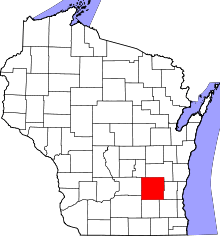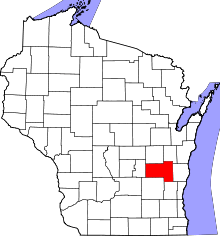Waupun, Wisconsin
| Waupun, Wisconsin | |
|---|---|
| City | |
|
Sign on WIS 26 | |
 Location of Waupun, Wisconsin | |
| Coordinates: 43°37′54″N 88°44′9″W / 43.63167°N 88.73583°WCoordinates: 43°37′54″N 88°44′9″W / 43.63167°N 88.73583°W | |
| Country | United States |
| State | Wisconsin |
| Counties | Dodge, Fond du Lac |
| Area[1] | |
| • Total | 4.44 sq mi (11.50 km2) |
| • Land | 4.39 sq mi (11.37 km2) |
| • Water | 0.05 sq mi (0.13 km2) |
| Elevation[2] | 892 ft (272 m) |
| Population (2010)[3] | |
| • Total | 11,340 |
| • Estimate (2012[4]) | 11,295 |
| • Density | 2,583.1/sq mi (997.3/km2) |
| Time zone | Central (CST) (UTC-6) |
| • Summer (DST) | CDT (UTC-5) |
| ZIP code | 53963 |
| Area code(s) | 920 |
| FIPS code | 55-84425[5] |
| GNIS feature ID | 1576324[2] |
| Website | www.cityofwaupun.org |
Waupun /wɔːˈpʌn/[6] is a city in Dodge and Fond du Lac counties in the U.S. state of Wisconsin. The population was 11,340 at the 2010 census.[7] Of this, 7,864 were in Dodge County, and 3,476 were in Fond du Lac County. In Fond du Lac County, there is also the Town of Waupun which abuts the city of Waupun.
History
Waupun comes from the Ojibwe word "Waubun" which means "dawn of day."[8] In fact Waupun was originally supposed to be named "Waubun" but the State of Wisconsin made a spelling error, and Waupun never bothered to change it.
Waupun was founded in 1839 by Seymour Wilcox, the first settler along the Rock River in what was then deciduous forested land. The territorial Census in 1847 showed Waupun Township to have a population of 956. In 1851, the city was chosen for the State Penitentiary, owing to the abundance of limestone for construction. The main building, constructed in 1854, is still in use. The population in 1940 was 6,725.
Geography
Waupun is located at 43°37′54″N 88°44′9″W / 43.63167°N 88.73583°W (43.631577, -88.735835).[9]
According to the United States Census Bureau, the city has a total area of 4.44 square miles (11.50 km2), of which, 4.39 square miles (11.37 km2) is land and 0.05 square miles (0.13 km2) is water.[1]
The relief of the city is moderate, ranging from 870 feet (270 m) at the Rock River, to its highest elevation of 941 feet (287 m) above sea level.
Waupun lies near the edge of the Horicon Marsh, the largest cattail marsh in the United States, and is the principal access point to wildlife viewing for the Horicon Wildlife Refuges.
The Fond du Lac County Park, on the edge of Waupun, has preserved a remnant stand of old-growth southern mesic forest, which once covered over 3 million acres (12,000 km2) of Southern Wisconsin. The Fond du Lac County Park also provides camping.
Transportation
US 151 is an expressway that bypasses east of the city, Wisconsin 26 along Fond du Lac St. and Watertown St., Wisconsin 49 along Main St., Wisconsin 68 along Fox Lake Rd, and Business US 151 along Madison St., Main St., and Fond du Lac St. The city is also served by Fond du Lac County Hwy AW, Hwy I, Hwy M and Hwy MMM.
The US 151 Bypass has 4 exits to serve Waupun. They are at Business 151, Wis 26, Wis 49, and Wis 26/Business 151.
Demographics
| Historical population | |||
|---|---|---|---|
| Census | Pop. | %± | |
| 1860 | 1,736 | — | |
| 1870 | 1,935 | 11.5% | |
| 1880 | 2,353 | 21.6% | |
| 1890 | 2,757 | 17.2% | |
| 1900 | 3,185 | 15.5% | |
| 1910 | 3,362 | 5.6% | |
| 1920 | 4,440 | 32.1% | |
| 1930 | 5,768 | 29.9% | |
| 1940 | 6,798 | 17.9% | |
| 1950 | 6,725 | −1.1% | |
| 1960 | 7,935 | 18.0% | |
| 1970 | 7,946 | 0.1% | |
| 1980 | 8,132 | 2.3% | |
| 1990 | 8,207 | 0.9% | |
| 2000 | 10,718 | 30.6% | |
| 2010 | 11,340 | 5.8% | |
| Est. 2015 | 11,343 | [10] | 0.0% |
2010 census
As of the census[3] of 2010, there were 11,340 people, 3,485 households, and 2,259 families residing in the city. The population density was 2,583.1 inhabitants per square mile (997.3/km2). There were 3,703 housing units at an average density of 843.5 per square mile (325.7/km2). The racial makeup of the city was 84.7% White, 12.2% African American, 1.2% Native American, 0.3% Asian, 0.2% Pacific Islander, 0.5% from other races, and 0.9% from two or more races. Hispanic or Latino of any race were 1.9% of the population.
There were 3,485 households of which 30.8% had children under the age of 18 living with them, 50.1% were married couples living together, 9.2% had a female householder with no husband present, 5.5% had a male householder with no wife present, and 35.2% were non-families. 30.4% of all households were made up of individuals and 13.1% had someone living alone who was 65 years of age or older. The average household size was 2.35 and the average family size was 2.91.
The median age in the city was 36.4 years. 17.6% of residents were under the age of 18; 11% were between the ages of 18 and 24; 35.1% were from 25 to 44; 23.4% were from 45 to 64; and 12.9% were 65 years of age or older. The gender makeup of the city was 61.0% male and 39.0% female.
2000 census
As of the census[5] of 2000, there were 10,718 people, 3,351 households, and 2,228 families residing in the city. The population density was 2,906.3 people per square mile (1,121.5/km²). There were 3,512 housing units at an average density of 952.3 per square mile (367.5/km²). The racial makeup of the city was 86.06% White, 11.81% African American, 0.91% Native American, 0.26% Asian, 0.05% Pacific Islander, 0.51% from other races, and 0.40% from two or more races. Hispanic or Latino of any race were 2.84% of the population.
There were 3,351 households out of which 32.2% had children under the age of 18 living with them, 54.1% were married couples living together, 9.3% had a female householder with no husband present, and 33.5% were non-families. 29.6% of all households were made up of individuals and 15.0% had someone living alone who was 65 years of age or older. The average household size was 2.38 and the average family size was 2.96.
In the city the population was spread out with 19.9% under the age of 18, 11.6% from 18 to 24, 36.1% from 25 to 44, 18.9% from 45 to 64, and 13.4% who were 65 years of age or older. The median age was 35 years. For every 100 females there were 150.0 males. For every 100 females age 18 and over, there were 161.2 males.
The median in the city was $40,597, and the median income for a family was $50,820. Males had a median income of $34,795 versus $23,517 for females. The per capita income for the city was $16,947. About 4.4% of families and 5.5% of the population were below the poverty line, including 5.3% of those under age 18 and 8.3% of those age 65 or over.
(Note: The above statistics may not accurately reflect the civilian population, as the census includes 2,741 incarcerated males (2008) in Waupun's state correctional institutions.)
Economy
Alto Dairy Cooperative, a farmer-owned dairy cooperative in Waupun was sold to Saputo Cheese in 2008.[12]
Culture
Waupun is home to a collection of outdoor sculptures by Clarence Addison Shaler, a manufacturer, inventor, and sculptor from the area. In Shaler Park is the well-known "End of the Trail" statue, depicting a Native American slumped on a horse, representing the fate of native people. Other Shaler sculptures are found throughout the city, including The Dawn of Day, Who Sows Believes in God, the Pioneers, and The Recording Angel, among others.[13]
Correctional institutions
Waupun is also known as "The Prison City."[14] The Dodge Correctional Institution, John C. Burke Correctional Center, and Waupun Correctional Institution are located in Waupun.
Images
 City hall
City hall Former Waupun Public Library, now a museum, registered historic place
Former Waupun Public Library, now a museum, registered historic place Waupun sign on WIS 68
Waupun sign on WIS 68 Central Wisconsin Christian School
Central Wisconsin Christian School
Notable people
- Frank L. Bacon, Wisconsin State Assemblyman
- Thomas Bowen, Wisconsin State Senator
- Henry Waldo Coe, frontier physician and politician
- Glenn Robert Davis, U.S. Representative
- Fond du Lac County Jane Doe, unidentified murder victim found in 2008[15]
- Yasmin Farooq, 1996 Olympian (rowing cox)
- Fred H. Hildebrandt, U.S. Representative from South Dakota
- Joe Hauser, baseball player
- Orville W. Mosher, Wisconsin State Senator
- Tom Mullica, magician and comedian
- Magdalen Redman, All-American Girls Professional Baseball League player
- David F. Simpson, Minnesota Supreme Court justice[16]
- Oliver Smith, stage designer
- John van Hengel, Food Bank founder
- Ferdinand T. Yahr, Wisconsin State Senator
- Chauncey W. Yockey, Wisconsin State Assemblyman
References
- 1 2 "US Gazetteer files 2010". United States Census Bureau. Retrieved 2012-11-18.
- 1 2 "US Board on Geographic Names". United States Geological Survey. 2007-10-25. Retrieved 2008-01-31.
- 1 2 "American FactFinder". United States Census Bureau. Retrieved 2012-11-18.
- ↑ "Population Estimates". United States Census Bureau. Retrieved 2013-06-24.
- 1 2 "American FactFinder". United States Census Bureau. Retrieved 2008-01-31.
- ↑ http://www.misspronouncer.com/towns/waupun.html
- ↑ 2010 Census returns
- ↑ Waubun Minnesota Vacation Destination - Tamarac National Wildlife Rescue. Park Rapids Chamber http://parkrapids.com/neighborhoods/waubun.htm. Retrieved 23 March 2014. Missing or empty
|title=(help) - ↑ "US Gazetteer files: 2010, 2000, and 1990". United States Census Bureau. 2011-02-12. Retrieved 2011-04-23.
- ↑ "Annual Estimates of the Resident Population for Incorporated Places: April 1, 2010 to July 1, 2015". Retrieved July 2, 2016.
- ↑ "Census of Population and Housing". Census.gov. Retrieved June 4, 2015.
- ↑ USDA Rural Development, Alto Members Approve Sale to Saputo Cheese USA, retrieved February 16, 2013.
- ↑ Chelsey Lewis. "Waupun's sculptures are worth a visit". Wisconsin Trails
- ↑ http://www.soldiershome.org/our_story/ems_letter_1865.htm
- ↑ Hicks, Brad (29 February 2012). "Unraveling the Jane Doe Mystery". Fox News. Retrieved 25 July 2014.
- ↑ Minnesota State Law Library-David F. Simpson
External links
| Wikimedia Commons has media related to Waupun, Wisconsin. |


